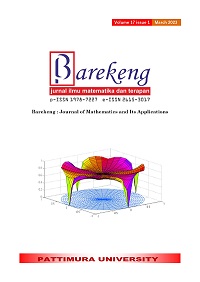ESTIMATION OF MAXIMUM LIKELIHOOD WEIGHTED LOGISTIC REGRESSION USING GENETIC ALGORITHM (CASE STUDY: INDIVIDUAL WORK STATUS IN MALANG CITY)
Abstract
Weighted Logistic Regression (WLR) is a method used to overcome imbalanced data or rare events by using weighting and is part of the development of a simple logistic regression model. Parameter estimation of the WLR model uses Maximum Likelihood estimation. The maximum likelihood parameter estimator value is obtained using an optimization approach. The Genetic algorithm is an optimization computational algorithm that is used to optimize the estimation of model parameters. This study aims to estimate the Maximum Likelihood Weighted Logistic Regression with the applied genetic algorithm and determine the significant variables that affect the working status of individuals in Malang City. The data used is the result of data collection from the National Labor Force Survey of Malang City in 2020. The results of the analysis show that the variable education completed and the number of household members has a significant effect on individual work status in Malang City.
Downloads
References
X. Zou, Y. Hu, Z. Tian, and K. Shen, “Logistic Regression Model Optimization and Case Analysis,” Proc. IEEE 7th Int. Conf. Comput. Sci. Netw. Technol. ICCSNT 2019, pp. 135–139, October 19-20 2019.
M. Maalouf, D. Homouz, and T. B. Trafalis, “Logistic regression in large rare events and imbalanced data: A performance comparison of prior correction and weighting methods,” Comput. Intell., vol. 34, no. 1, pp. 161–174, February 2017.
R. K. Vinayak, W. Kong, G. Valiant, and S. Kakade, “Maximum likelihood estimation for learning populations of parameters,” 36th Int. Conf. Mach. Learn. ICML 2019, vol. 2019-June, pp. 11217–11226, February 2019.
D. E. A. Sulasih, S. Wulan Purnami, and S. Puteri Rahayu, “the Theoretical Study of Rare Event Weighted Logistic Regression for Classification of Imbalanced Data,” Int. Conf. Sci. Technol. Humanit., pp. 159–169, December 07 2015.
A. M. García, I. Santé, M. Boullón, and R. Crecente, “Calibration of an urban cellular automaton model by using statistical techniques and a genetic algorithm. Application to a small urban settlement of NW Spain,” Int. J. Geogr. Inf. Sci., vol. 27, no. 8, pp. 1593–1611, November 2013.
Z. Xia, K. Mao, S. Wei, X. Wang, Y. Fang, and S. Yang, “Application of genetic algorithm support vector regression model to predict damping of cantilever beam with particle damper,” J. Low Freq. Noise Vib. Act. Control, vol. 36, no. 2, pp. 138–147, June 2017.
E. Demir and Ö. Akkuş, “An Introductory Study on ‘ How the Genetic Algorithm Works in the Parameter Estimation of Binary Logit Model ?,’” Int. J. Sci. Basic Appl. Res., vol. 19, pp. 162–180, January 2015.
A. Salim and M. R. Alfian, “Optimalisasi Regresi Logistik Menggunakan Algoritma Genetika Pada Data Klasifikasi,” J. Teknol. Inf. dan Terap., vol. 6, no. 2, pp. 50–55, December 2019.
A. Yalçınkaya, İ. G. Balay, and B. Şenoǧlu, “A new approach using the genetic algorithm for parameter estimation in multiple linear regression with long-tailed symmetric distributed error terms: An application to the Covid-19 data,” Chemom. Intell. Lab. Syst., vol. 216, June 2021.
Badan Pusat Statistik, “Laporan Eksekutif Ketenagakerjaan Kota Malang 2020,” BPS Kota Malang, 2020.
Z. Qiu, H. Li, H. Su, G. Ou, and T. Wang, “Logistic regression bias correction for large scale data with rare events,” Lect. Notes Comput. Sci. (including Subser. Lect. Notes Artif. Intell. Lect. Notes Bioinformatics), vol. 8347 LNAI, no. PART 2, pp. 133–144, December 2013.
D. W. Hosmer and S. Lemeshow, Applied Logistic Regression Second Edition. Canada: John Wiley and Sons,Inc, 2000.
M. Maalouf and M. Siddiqi, “Weighted logistic regression for large-scale imbalanced and rare events data,” IIE Annu. Conf. Expo 2014, vol. 59, pp. 142–148, March 2014.
E. E. Elmahdy and A. W. Aboutahoun, “A new approach for parameter estimation of finite Weibull mixture distributions for reliability modeling,” Appl. Math. Model., vol. 37, no. 4, pp. 1800–1810, February 2013.
T. Alam et al., “Genetic Algorithm : Reviews , Implementations and Applications,” Int. J. Eng. Pedagog., vol. 10, no. 6, pp. 57–77, August 2020.
S. Katoch, S. S. Chauhan, and V. Kumar, A review on genetic algorithm: past, present, and future, vol. 80, no. 5. Multimedia Tools and Applications, February 2021.
Copyright (c) 2023 Dahlia Gladiola Rurina Menufandu, Rahma Fitriani, Eni Sumarminingsih

This work is licensed under a Creative Commons Attribution-ShareAlike 4.0 International License.
Authors who publish with this Journal agree to the following terms:
- Author retain copyright and grant the journal right of first publication with the work simultaneously licensed under a creative commons attribution license that allow others to share the work within an acknowledgement of the work’s authorship and initial publication of this journal.
- Authors are able to enter into separate, additional contractual arrangement for the non-exclusive distribution of the journal’s published version of the work (e.g. acknowledgement of its initial publication in this journal).
- Authors are permitted and encouraged to post their work online (e.g. in institutional repositories or on their websites) prior to and during the submission process, as it can lead to productive exchanges, as well as earlier and greater citation of published works.






1.gif)



